Albanian vs Portuguese Community Comparison
COMPARE
Albanian
Portuguese
Social Comparison
Social Comparison
Albanians
Portuguese
7,071
SOCIAL INDEX
68.2/ 100
SOCIAL RATING
131st/ 347
SOCIAL RANK
4,363
SOCIAL INDEX
41.1/ 100
SOCIAL RATING
201st/ 347
SOCIAL RANK
Portuguese Integration in Albanian Communities
The statistical analysis conducted on geographies consisting of 181,514,518 people shows a mild positive correlation between the proportion of Portuguese within Albanian communities in the United States with a correlation coefficient (R) of 0.368. On average, for every 1% (one percent) increase in Albanians within a typical geography, there is an increase of 0.087% in Portuguese. To illustrate, in a geography comprising of 100,000 individuals, a rise of 1,000 Albanians corresponds to an increase of 86.5 Portuguese.
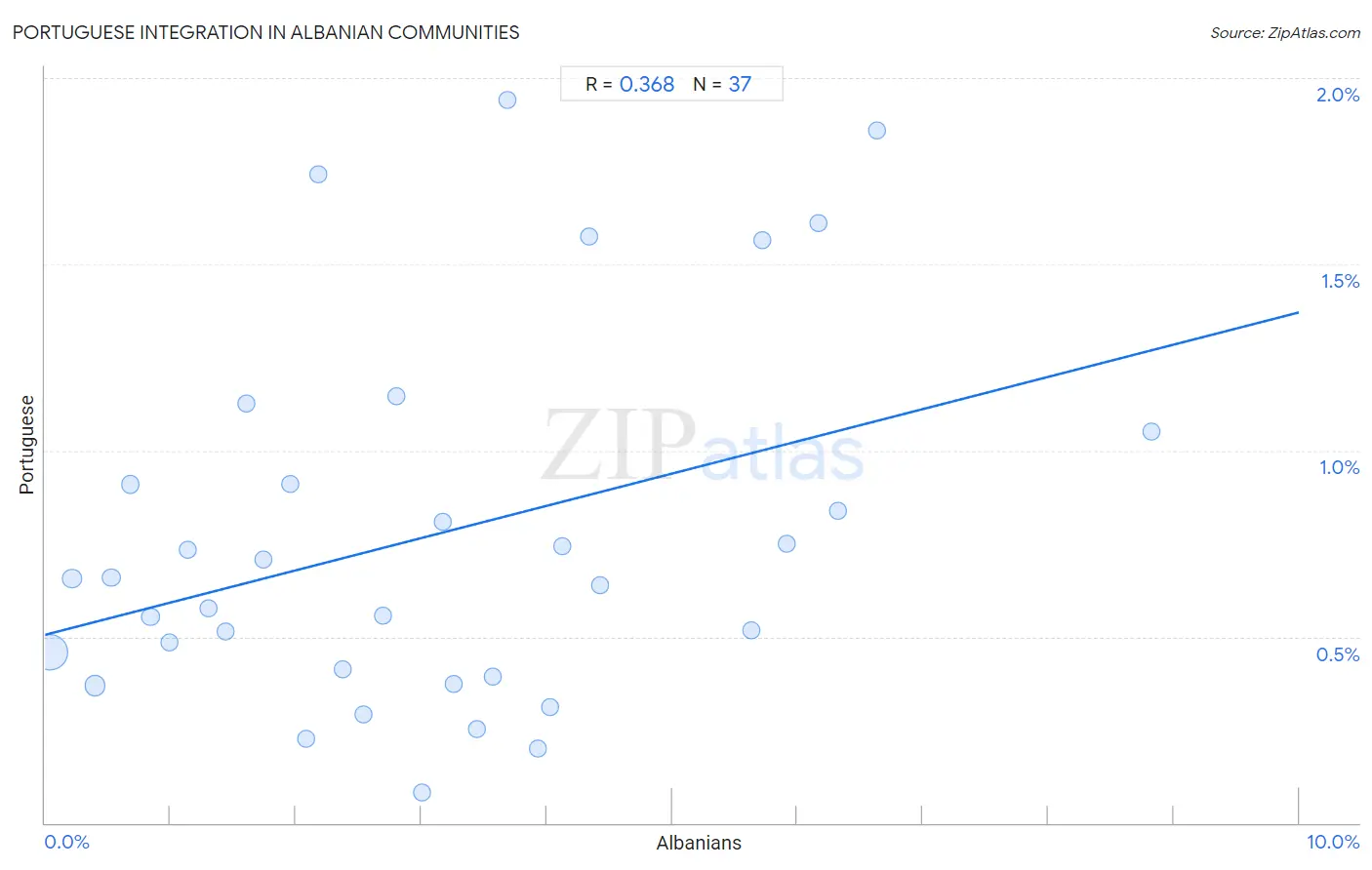
Albanian vs Portuguese Income
When considering income, the most significant differences between Albanian and Portuguese communities in the United States are seen in wage/income gap (25.4% compared to 27.4%, a difference of 7.6%), per capita income ($47,379 compared to $44,362, a difference of 6.8%), and median female earnings ($42,584 compared to $40,177, a difference of 6.0%). Conversely, both communities are more comparable in terms of median household income ($89,744 compared to $88,976, a difference of 0.86%), householder income ages 45 - 64 years ($106,243 compared to $105,309, a difference of 0.89%), and householder income under 25 years ($53,794 compared to $54,436, a difference of 1.2%).

| Income Metric | Albanian | Portuguese |
| Per Capita Income | Exceptional $47,379 | Good $44,362 |
| Median Family Income | Exceptional $109,136 | Excellent $106,286 |
| Median Household Income | Exceptional $89,744 | Exceptional $88,976 |
| Median Earnings | Exceptional $50,116 | Exceptional $48,032 |
| Median Male Earnings | Exceptional $58,680 | Excellent $56,663 |
| Median Female Earnings | Exceptional $42,584 | Good $40,177 |
| Householder Age | Under 25 years | Exceptional $53,794 | Exceptional $54,436 |
| Householder Age | 25 - 44 years | Exceptional $101,367 | Exceptional $99,429 |
| Householder Age | 45 - 64 years | Exceptional $106,243 | Exceptional $105,309 |
| Householder Age | Over 65 years | Fair $60,249 | Good $61,440 |
| Wage/Income Gap | Good 25.4% | Tragic 27.4% |
Albanian vs Portuguese Poverty
When considering poverty, the most significant differences between Albanian and Portuguese communities in the United States are seen in female poverty among 25-34 year olds (12.5% compared to 13.6%, a difference of 9.4%), married-couple family poverty (5.0% compared to 4.6%, a difference of 9.3%), and seniors poverty over the age of 65 (11.2% compared to 10.5%, a difference of 6.5%). Conversely, both communities are more comparable in terms of male poverty (10.6% compared to 10.6%, a difference of 0.13%), child poverty among boys under 16 (15.6% compared to 15.5%, a difference of 0.27%), and child poverty among girls under 16 (15.4% compared to 15.3%, a difference of 0.48%).
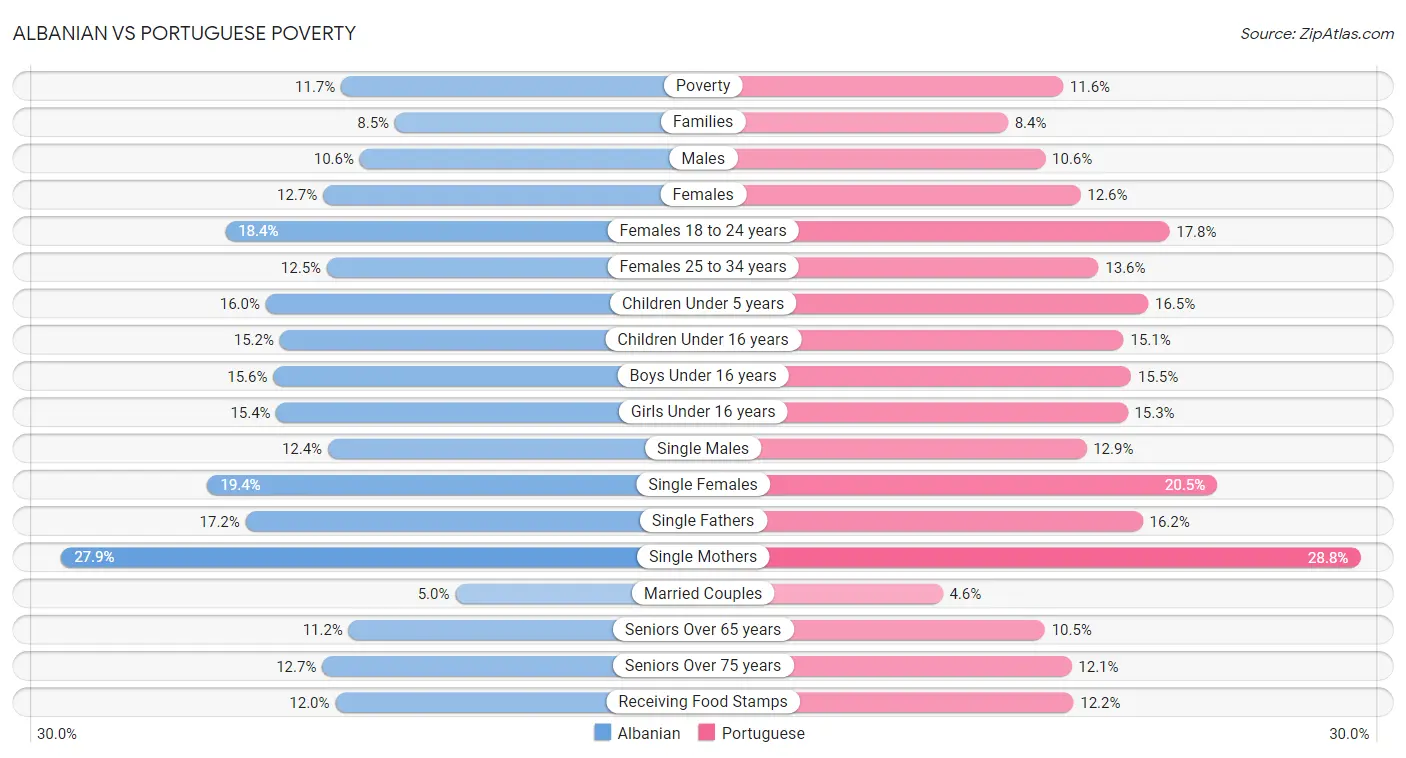
| Poverty Metric | Albanian | Portuguese |
| Poverty | Exceptional 11.7% | Exceptional 11.6% |
| Families | Excellent 8.5% | Excellent 8.4% |
| Males | Exceptional 10.6% | Exceptional 10.6% |
| Females | Exceptional 12.7% | Exceptional 12.6% |
| Females 18 to 24 years | Exceptional 18.4% | Exceptional 17.8% |
| Females 25 to 34 years | Exceptional 12.5% | Average 13.6% |
| Children Under 5 years | Exceptional 16.0% | Excellent 16.5% |
| Children Under 16 years | Excellent 15.2% | Exceptional 15.1% |
| Boys Under 16 years | Excellent 15.6% | Excellent 15.5% |
| Girls Under 16 years | Exceptional 15.4% | Exceptional 15.3% |
| Single Males | Exceptional 12.4% | Fair 12.9% |
| Single Females | Exceptional 19.4% | Excellent 20.5% |
| Single Fathers | Tragic 17.2% | Good 16.2% |
| Single Mothers | Exceptional 27.9% | Good 28.8% |
| Married Couples | Good 5.0% | Exceptional 4.6% |
| Seniors Over 65 years | Fair 11.2% | Excellent 10.5% |
| Seniors Over 75 years | Tragic 12.7% | Good 12.1% |
| Receiving Food Stamps | Fair 12.0% | Fair 12.2% |
Albanian vs Portuguese Unemployment
When considering unemployment, the most significant differences between Albanian and Portuguese communities in the United States are seen in unemployment among seniors over 75 years (8.6% compared to 10.4%, a difference of 20.5%), unemployment among women with children under 6 years (7.2% compared to 8.0%, a difference of 11.7%), and unemployment among ages 30 to 34 years (5.4% compared to 5.9%, a difference of 9.4%). Conversely, both communities are more comparable in terms of unemployment among ages 60 to 64 years (4.7% compared to 4.7%, a difference of 0.76%), unemployment (5.3% compared to 5.4%, a difference of 1.8%), and unemployment among ages 55 to 59 years (5.0% compared to 5.1%, a difference of 2.0%).
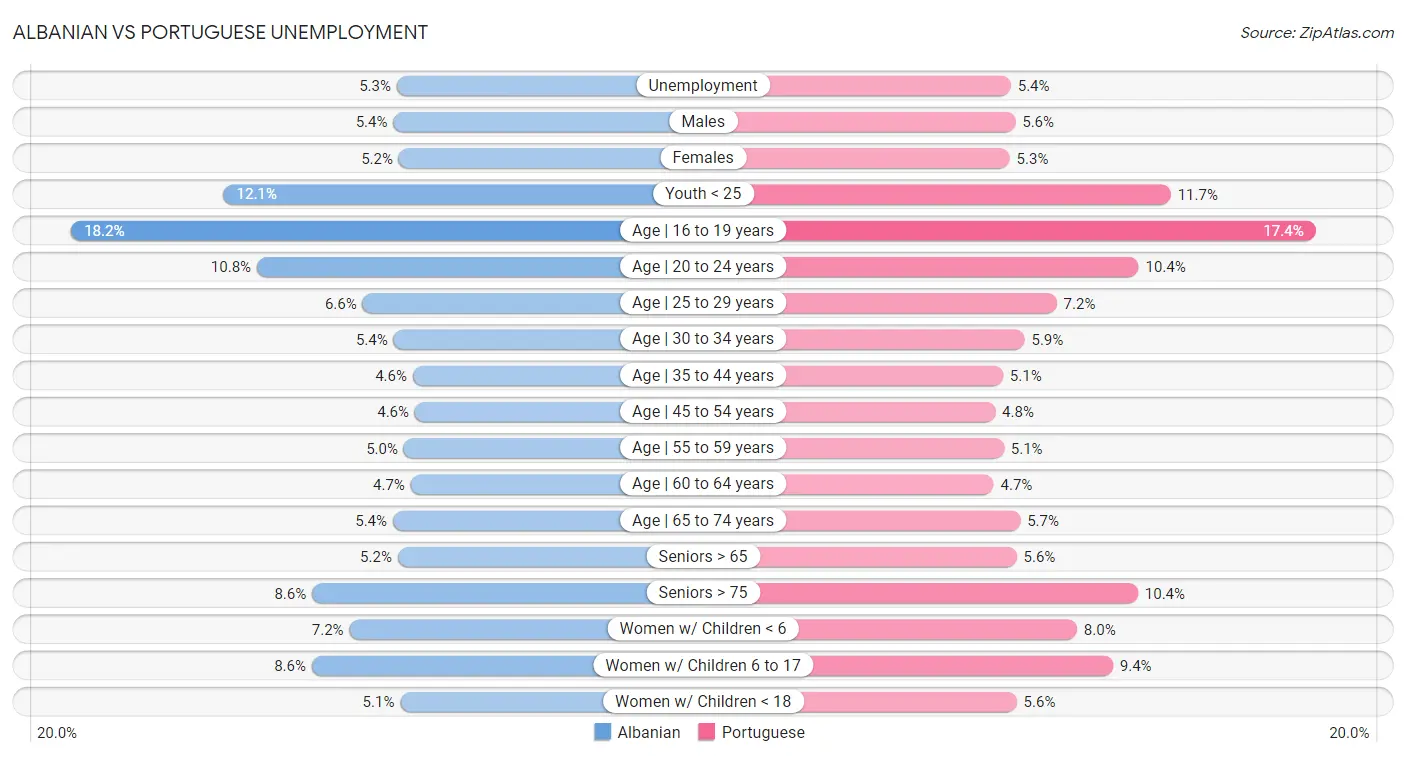
| Unemployment Metric | Albanian | Portuguese |
| Unemployment | Average 5.3% | Poor 5.4% |
| Males | Poor 5.4% | Tragic 5.6% |
| Females | Good 5.2% | Fair 5.3% |
| Youth < 25 | Tragic 12.1% | Fair 11.7% |
| Age | 16 to 19 years | Tragic 18.2% | Good 17.4% |
| Age | 20 to 24 years | Tragic 10.8% | Fair 10.4% |
| Age | 25 to 29 years | Average 6.6% | Tragic 7.2% |
| Age | 30 to 34 years | Good 5.4% | Tragic 5.9% |
| Age | 35 to 44 years | Good 4.6% | Tragic 5.1% |
| Age | 45 to 54 years | Fair 4.6% | Tragic 4.8% |
| Age | 55 to 59 years | Tragic 5.0% | Tragic 5.1% |
| Age | 60 to 64 years | Exceptional 4.7% | Exceptional 4.7% |
| Age | 65 to 74 years | Poor 5.4% | Tragic 5.7% |
| Seniors > 65 | Tragic 5.2% | Tragic 5.6% |
| Seniors > 75 | Good 8.6% | Tragic 10.4% |
| Women w/ Children < 6 | Exceptional 7.2% | Tragic 8.0% |
| Women w/ Children 6 to 17 | Exceptional 8.6% | Tragic 9.4% |
| Women w/ Children < 18 | Exceptional 5.1% | Poor 5.6% |
Albanian vs Portuguese Labor Participation
When considering labor participation, the most significant differences between Albanian and Portuguese communities in the United States are seen in in labor force | age 16-19 (36.5% compared to 40.0%, a difference of 9.5%), in labor force | age 20-24 (74.6% compared to 76.4%, a difference of 2.5%), and in labor force | age 30-34 (85.7% compared to 84.0%, a difference of 2.1%). Conversely, both communities are more comparable in terms of in labor force | age 35-44 (85.1% compared to 84.3%, a difference of 0.95%), in labor force | age 45-54 (83.3% compared to 82.2%, a difference of 1.3%), and in labor force | age 25-29 (85.5% compared to 84.4%, a difference of 1.3%).

| Labor Participation Metric | Albanian | Portuguese |
| In Labor Force | Age > 16 | Good 65.3% | Tragic 64.4% |
| In Labor Force | Age 20-64 | Exceptional 80.2% | Tragic 79.1% |
| In Labor Force | Age 16-19 | Average 36.5% | Exceptional 40.0% |
| In Labor Force | Age 20-24 | Poor 74.6% | Exceptional 76.4% |
| In Labor Force | Age 25-29 | Exceptional 85.5% | Fair 84.4% |
| In Labor Force | Age 30-34 | Exceptional 85.7% | Tragic 84.0% |
| In Labor Force | Age 35-44 | Exceptional 85.1% | Fair 84.3% |
| In Labor Force | Age 45-54 | Exceptional 83.3% | Tragic 82.2% |
Albanian vs Portuguese Family Structure
When considering family structure, the most significant differences between Albanian and Portuguese communities in the United States are seen in single father households (2.0% compared to 2.5%, a difference of 24.7%), births to unmarried women (28.5% compared to 33.8%, a difference of 18.5%), and single mother households (5.9% compared to 6.4%, a difference of 8.0%). Conversely, both communities are more comparable in terms of average family size (3.17 compared to 3.19, a difference of 0.68%), currently married (47.0% compared to 47.3%, a difference of 0.81%), and married-couple households (46.1% compared to 47.8%, a difference of 3.6%).

| Family Structure Metric | Albanian | Portuguese |
| Family Households | Tragic 63.5% | Exceptional 65.8% |
| Family Households with Children | Tragic 26.5% | Good 27.6% |
| Married-couple Households | Fair 46.1% | Exceptional 47.8% |
| Average Family Size | Tragic 3.17 | Tragic 3.19 |
| Single Father Households | Exceptional 2.0% | Tragic 2.5% |
| Single Mother Households | Exceptional 5.9% | Fair 6.4% |
| Currently Married | Good 47.0% | Excellent 47.3% |
| Divorced or Separated | Exceptional 11.5% | Fair 12.2% |
| Births to Unmarried Women | Exceptional 28.5% | Tragic 33.8% |
Albanian vs Portuguese Vehicle Availability
When considering vehicle availability, the most significant differences between Albanian and Portuguese communities in the United States are seen in no vehicles in household (15.6% compared to 8.6%, a difference of 82.6%), 4 or more vehicles in household (4.8% compared to 7.4%, a difference of 54.8%), and 3 or more vehicles in household (15.8% compared to 21.8%, a difference of 38.1%). Conversely, both communities are more comparable in terms of 1 or more vehicles in household (84.4% compared to 91.6%, a difference of 8.4%), 2 or more vehicles in household (49.0% compared to 58.6%, a difference of 19.7%), and 3 or more vehicles in household (15.8% compared to 21.8%, a difference of 38.1%).

| Vehicle Availability Metric | Albanian | Portuguese |
| No Vehicles Available | Tragic 15.6% | Exceptional 8.6% |
| 1+ Vehicles Available | Tragic 84.4% | Exceptional 91.6% |
| 2+ Vehicles Available | Tragic 49.0% | Exceptional 58.6% |
| 3+ Vehicles Available | Tragic 15.8% | Exceptional 21.8% |
| 4+ Vehicles Available | Tragic 4.8% | Exceptional 7.4% |
Albanian vs Portuguese Education Level
When considering education level, the most significant differences between Albanian and Portuguese communities in the United States are seen in master's degree (17.0% compared to 13.9%, a difference of 21.9%), professional degree (4.9% compared to 4.1%, a difference of 20.3%), and bachelor's degree (40.9% compared to 35.5%, a difference of 15.2%). Conversely, both communities are more comparable in terms of nursery school (98.0% compared to 98.0%, a difference of 0.020%), kindergarten (97.9% compared to 97.9%, a difference of 0.020%), and 1st grade (97.9% compared to 97.9%, a difference of 0.020%).
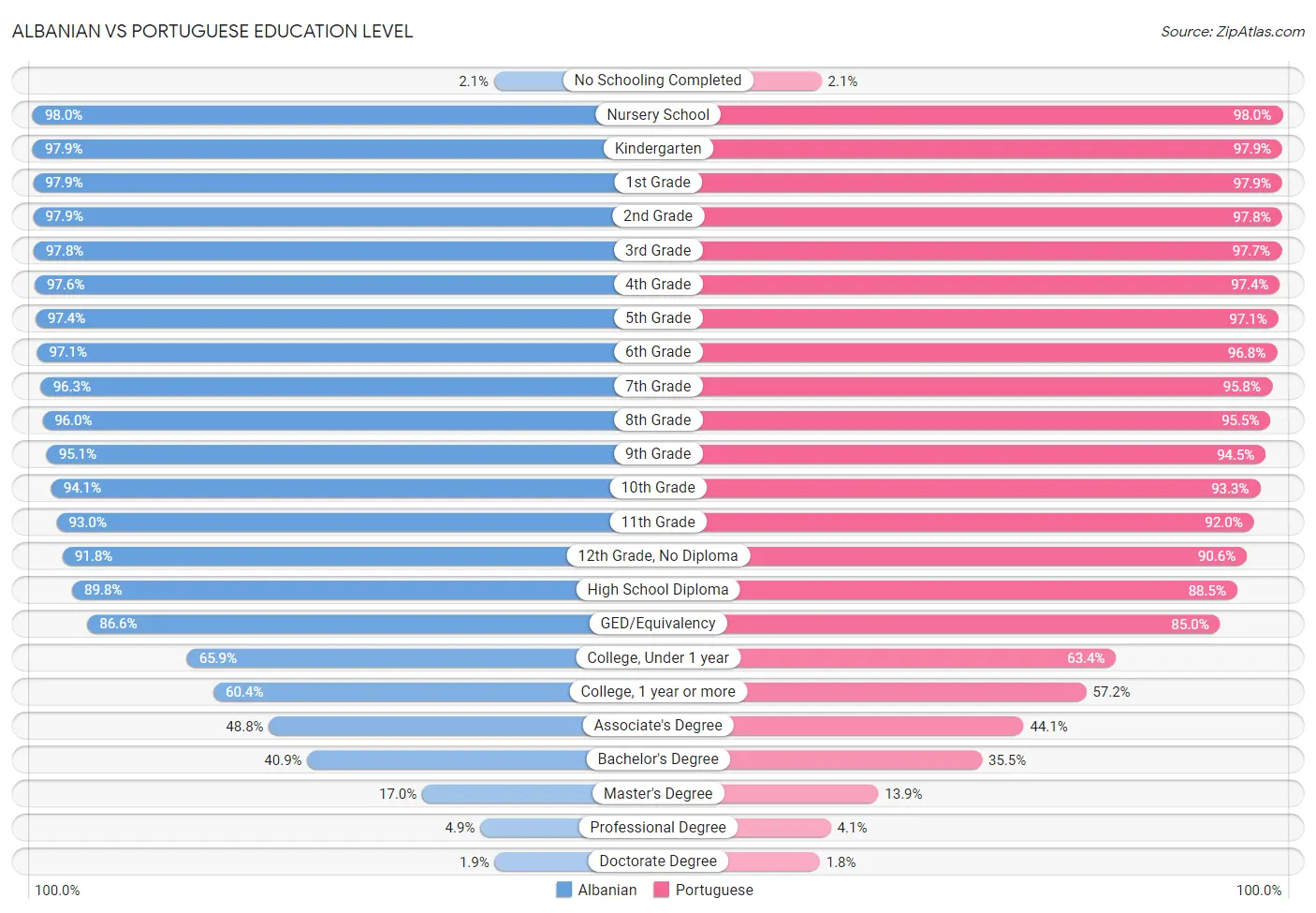
| Education Level Metric | Albanian | Portuguese |
| No Schooling Completed | Good 2.1% | Average 2.1% |
| Nursery School | Average 98.0% | Average 98.0% |
| Kindergarten | Average 97.9% | Average 97.9% |
| 1st Grade | Average 97.9% | Average 97.9% |
| 2nd Grade | Average 97.9% | Average 97.8% |
| 3rd Grade | Average 97.8% | Fair 97.7% |
| 4th Grade | Good 97.6% | Fair 97.4% |
| 5th Grade | Good 97.4% | Tragic 97.1% |
| 6th Grade | Average 97.1% | Tragic 96.8% |
| 7th Grade | Excellent 96.3% | Poor 95.8% |
| 8th Grade | Excellent 96.0% | Poor 95.5% |
| 9th Grade | Good 95.1% | Tragic 94.5% |
| 10th Grade | Excellent 94.1% | Poor 93.3% |
| 11th Grade | Excellent 93.0% | Tragic 92.0% |
| 12th Grade, No Diploma | Excellent 91.8% | Poor 90.6% |
| High School Diploma | Excellent 89.8% | Poor 88.5% |
| GED/Equivalency | Excellent 86.6% | Poor 85.0% |
| College, Under 1 year | Good 65.9% | Tragic 63.4% |
| College, 1 year or more | Good 60.4% | Tragic 57.2% |
| Associate's Degree | Exceptional 48.8% | Tragic 44.1% |
| Bachelor's Degree | Exceptional 40.9% | Tragic 35.5% |
| Master's Degree | Exceptional 17.0% | Poor 13.9% |
| Professional Degree | Exceptional 4.9% | Poor 4.1% |
| Doctorate Degree | Good 1.9% | Fair 1.8% |
Albanian vs Portuguese Disability
When considering disability, the most significant differences between Albanian and Portuguese communities in the United States are seen in disability age under 5 (1.1% compared to 1.6%, a difference of 41.6%), hearing disability (2.9% compared to 3.5%, a difference of 17.4%), and disability age 18 to 34 (6.4% compared to 7.4%, a difference of 15.2%). Conversely, both communities are more comparable in terms of cognitive disability (16.8% compared to 16.9%, a difference of 0.52%), self-care disability (2.6% compared to 2.6%, a difference of 1.9%), and ambulatory disability (6.2% compared to 6.4%, a difference of 2.3%).
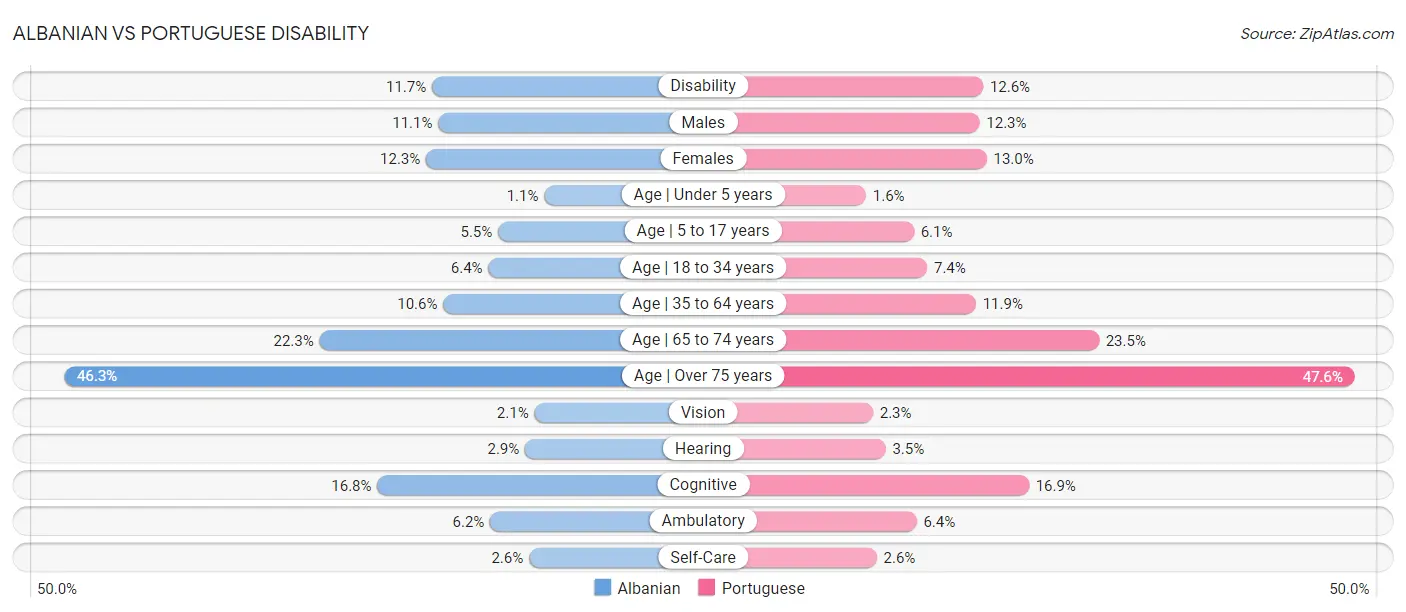
| Disability Metric | Albanian | Portuguese |
| Disability | Average 11.7% | Tragic 12.6% |
| Males | Good 11.1% | Tragic 12.3% |
| Females | Fair 12.3% | Tragic 13.0% |
| Age | Under 5 years | Exceptional 1.1% | Tragic 1.6% |
| Age | 5 to 17 years | Excellent 5.5% | Tragic 6.1% |
| Age | 18 to 34 years | Excellent 6.4% | Tragic 7.4% |
| Age | 35 to 64 years | Exceptional 10.6% | Tragic 11.9% |
| Age | 65 to 74 years | Exceptional 22.3% | Fair 23.5% |
| Age | Over 75 years | Exceptional 46.3% | Fair 47.6% |
| Vision | Exceptional 2.1% | Tragic 2.3% |
| Hearing | Good 2.9% | Tragic 3.5% |
| Cognitive | Exceptional 16.8% | Exceptional 16.9% |
| Ambulatory | Poor 6.2% | Tragic 6.4% |
| Self-Care | Tragic 2.6% | Tragic 2.6% |